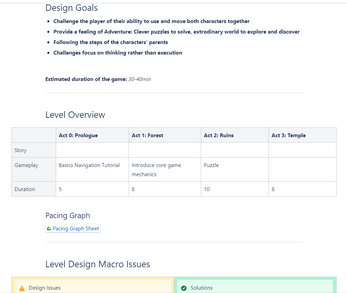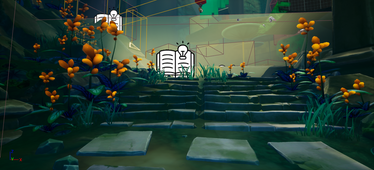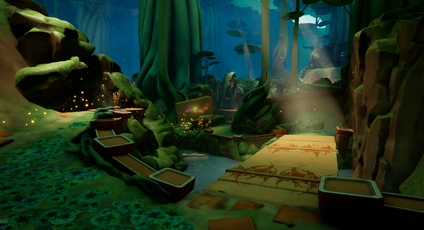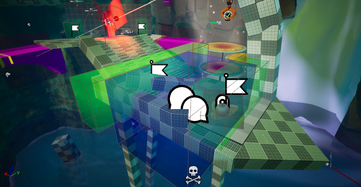Vincent TRINEL
Level Designer
Live Adventure

Platform: PC/Console
Team size: 11
Role: Level Designer / Game Designer
Period: October 2020 - June 2020 (9 month)

Live Adventure is a 2nd person adventure game that follows the expedition of a unique sibling duo of young explorers wannabes. The brother, Lence, holds the game camera, and the sister, Reel, is filmed by that same camera.
As a player, you have constant control over these two characters. You will have to use their abilities in synergy to explore and solve puzzles in the lost ruins of a lush forest.
This project is my graduation project. The original concept of a 2nd person camera gave me a huge challenge in both game and level design. I worked on the level design, the camera, the feeling of 3C and gameplay, and the design of some game mechanics.
My missions
-
Worked and refined the core concept with a team
-
Designed the core game mechanics with the design team
-
Helped designing the 3C and others game's system (hint system, grappling hook, HUD, etc.)
-
Established the layout of the levels on a large scale for designers to work in
-
Set up the pacing of the levels
-
Designed puzzles and traversal gameplay sequences
-
Designed and tweaked the camera effects
-
Scripted puzzle and narrative events (Dialogs, cutscenes, etc.)
-
Prototyped some gameplay sequences to quickly test gameplay sequences ideas and anticipate potential issues
-
Collaborated with artists on levels to facilitate level art and integration of graphic assets into levels
-
Collaborated with other level designers by exchanging bits of levels and giving each other regular feedback on our designs
-
Designed and tuned many subtle effects to improve the feel of some game mechanics and 3C.
Design
Design Documentation
Confluence
We used Confluence to write our design documentations. To start the creation of a level, I first established some design goals, then I defined the story and gameplay beats of the levels to achieve those goals.
Pacing Graph
After setting the design goals and level beats, I create a pacing graph. This is a graph where I put arbitrary values on each level beat for several parameters (challenge, tension, contrast, time, etc.). This helps me to anticipate pace issues and to better visualise the level. It is also an excellent tool for communicating with other team members.
Blockout & Iteration
The level design pipeline is based on iteration, experimentation and playtesting.
I iterate a lot on each level beat to always improve the level. As the camera is very unique on this game, I did a lot of quick abstract levels to test an idea to make sure it works with the game mechanics and supports our original game concept.
When I finish a level, I always find a new playtester to play it in order to find design issues and improve the level based on their feedback and my observations.
Scripting
A story-driven puzzle adventure game means that we also have scripting work for designers.
I did a lot of scripting for gameplay (Puzzle logic, grappling hooks, characters distance, checkpoints, etc.).
I also did a lot of scripting for the game's narrative (Dialogues, Cutscenes, Animations, etc.).
I used some tools and blueprints made by the programmers, and I scripted my own blueprints for specific cases.
Gameplay + Narration = Emotions!
For this project, I was able to experiment with something that interests me a lot: Linking gameplay and narrative to make the players feel emotions. In the game we designed gameplay sequences that serve the narrative.
For example, at the beginning of the game, the characters fall into a huge hole that takes them to a new world that is completely exotic and disorienting for them. To make this disorienting feeling come alive we designed an exotic gameplay sequence where the camera is upside down. This makes the already unconventional controls difficult for the player to grasp.
In the same way, at the end of the game, the characters have to leave the camera and move on together towards the next part of their adventure. Narratively we wanted to give the idea that the characters can only do this together and that Lence (the character holding the camera) learns to separate from the camera to continue his adventure. Regarding the gameplay, we see for the first time the character who has been holding the camera throughout the game, and to move forward the players will have to understand that they have to push both joysticks forward as they have learned throughout the game with the camera controls.
This moment was particularly appreciated by the players who really felt the emotional impact of this sequence.


The team
Game & Level designers:
Game artists:
Programmers:
Sound designers:
Eugene Abadie






























































